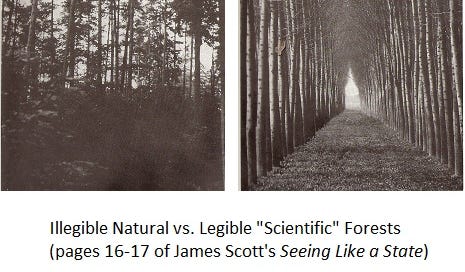Book Review: Seeing Like A State
In Seeing Like A State, James C. Scott writes about a (not so) mysterious force that affects governments. It’s called “high modernism”, and it’s what’s happens when people use “science” as an excuse to do whatever they think is best.
Seeing Like A State explains how the same phenomenon has caused the invention of taxes, last names, birthdays, standard currencies, standardized measurements, land titles, and urban planning projects. The book is long and dense and filled with specific details about mismanaged projects run by government bureaucrats. It also has quite a few interesting ideas that I will summarize below.
If it ain’t about the money
Governments tend to follow a repeatable pattern throughout history. They form when a group of independent and politically motivated people overthrow the existing government or decide to stake their claim on a piece of godforsaken land and start their own. This (sometimes) works well, but after a few generations all of the original visionaries are dead, and the government is filled with people who got the job through less spectacular methods. These people tend to be less interested in glorious revolution. Instead, they are interested in, erm, spreadsheets.
The book's central theme is that governments impose restrictions on their citizens to make accounting simpler, even if these methods don’t actually make anyone’s life better.
To make matters more complicated, project coordinators often insist that their plans are based on scientific principles. This makes it difficult to tell whether there is “real” science being done or if the person in charge is just a poseur using big words.
Modern high-modernism
I've been thinking about high modernism because a new form of it seems to be gaining popularity. We call it “data” and it shares many of the characteristics that Scott outlines in his book. Our obsession with data is caused by our desire to see the world in simple terms. Data helps governments and companies allocate resources more effectively at the expense of experiencing things firsthand. The danger begins when we interpret data as though it were a perfect representation of the real world, rather than an attempt to understand it.
This is not a new problem. Scott highlights the shortcomings of "scientific forestry", a process by which governments surveyed their lands to determine the amount of lumber available for harvest.
The first attempt at more precise measurements of forests was made by Johann Gottlieb Beckmann on a carefully surveyed sample plot. Walking abreast, several assistants carried compartmentalized boxes with color-coded nails corresponding to five categories of tree sizes, which they had been trained to identify. Each tree was tagged with the appropriate nail until the sample plot had been covered. __Because each assistant had begun with a certain number of nails, it was a simple matter to subtract the remaining nails from the initial total and arrive at an inventory of trees by class for the entire plot.__ The sample plot had been carefully chosen for its representativeness, allowing the foresters to then calculate the timber and, given certain price assumptions, the revenue yield of the whole forest.
(James C. Scott, Seeing Like a State)
Scientific forestry successfully determined a land plot's revenue potential, but this singular purpose blinded the government to how forests operated. It lead to the optimization of forests for lumber, stripping them of their diversity and creating a monoculture that collapsed after just one generation. At the time, scientific forestry was hailed as a modern triumph over the complexity of nature. In hindsight, it was an oversimplification to fulfill the financial desires of the central government.
The paradox here is that we are more advanced than previous generations, despite our shortcomings. Things have gotten tremendously better as a result of our constant efforts to make it so. Generations of scientists, engineers, and public officials have overseen tremendous feats of human accomplishment that have raised average living conditions far beyond what was available to even the wealthiest individuals in history.
Previous high modernism movements should teach us the need for humility. Done right, data can help us to plan for the future. It's a shortcut to the learned experience that can take a lifetime to accumulate. Like any shortcut, it comes with tradeoffs. Data is best used to supplement intuition, not as a replacement.
Companies that balance the urge of high modernism with the patience of intuitive decision-making are few and far between. Apple is a striking example of this blend.
In 1983, a young Steve Jobs gave a talk at the Aspen Design Conference. Although industrial designers mostly attended the event, Jobs made a habit of going each year. He was frustrated with other computer companies' aesthetic choices, who were releasing products that he thought were "garbage."
In his talk, he outlined why it was important to recruit talented designers to build the next generation of personal computers. The current models were too intimidating for the average person. He outlined a need for simplicity that would become a theme throughout his career. Computers were complicated, yes, but their designs did not need to be.
The Bauhaus-inspired neighborhoods of Silicon Valley inspired Jobs with their simple and modern designs. His childhood home had clean lines and large windows that conveyed simple sophistication for the working-class family. This aesthetic prioritized a minimalist design that was easy for the average person to understand intuitively.
Jobs brought this mentality to the table when creating products. He ruthlessly simplified user interfaces, eliminating anything that he considered non-essential for the core functionality. Apple's success created a wave of copycats. Sleek and minimalist designs flooded the market, incorrectly attributing Apple's success to the number of buttons on their machines. As a result, we've been taught that complexity to something to be eliminated. High modernist design is a double-edged sword — simplification without respect for the underlying complexity leads to dull and lifeless products.
Jobs' secret was that we never lost his connection to the mystical. Intuition is the experience of understanding something that cannot be simplified into words. It’s the result of thousands of years of evolution and is unlikely to be replaced with a few years of schooling.
Jobs described how his experiences with Eastern philosophy uniquely prepared him to walk the line of high modernism and intuition:
Western rational thought is not an innate human characteristic; it is learned and is the great achievement of Western civilization. In the villages of India, they never learned it. They learned something else, which is in some ways just as valuable but in other ways is not. That's the power of intuition and experiential wisdom.
Like previous high modernism movements, our obsession with data collection follows a predictable outcome. Venkatesh Rao of Ribbonfarm put it well:
High-modernist (think Bauhaus and Le Corbusier) aesthetics necessarily lead to simplification, since a reality that serves many purposes presents itself as illegible to a vision informed by a singular purpose. The big mistake in this pattern of failure is projecting your subjective lack of comprehension onto the object you are looking at, as “irrationality.” We make this mistake because we are tempted by a desire for legibility.
The reason the formula is generally dangerous, and a formula for failure, is that it does not operate by a thoughtful consideration of local/global tradeoffs, but through the imposition of a singular view as “best for all” in a pseudo-scientific sense. The high-modernist reformer does not acknowledge (and often genuinely does not understand) that he/she is engineering a shift in optima and power, with costs as well as benefits. Instead, the process is driven by a naive “best for everybody” paternalism, that genuinely intends to improve the lives of the people it affects. The high-modernist reformer is driven by a naive-scientific Utopian vision that does not tolerate dissent, because it believes it is dealing in scientific truths.
Seeing Like a State is a fascinating reminder that history works in cycles. Things that we take for granted today — common measurements, last names, taxes — all needed to be invented at some point. The process of implementing these things has not always gone smoothly, and the transition has been most difficult when the people in charge try to push through massive changes that disagree with hard-earned local customs.
I love data. And charts. They make me feel like the world is a neat and orderly place that can be managed from behind a laptop screen. This book served as a refreshing reminder of my own biases. It is a must-read for anyone looking to round-out their liberal arts education, especially if your work involves the large-scale coordination of people.
Related reading
Book Review: Seeing Like a State - Slate Star Codex
After Minimalism - David Perell
A Big Little Idea Called Legibility - Venkatesh Rao
Big Tech Sees Like A State - The Diff





